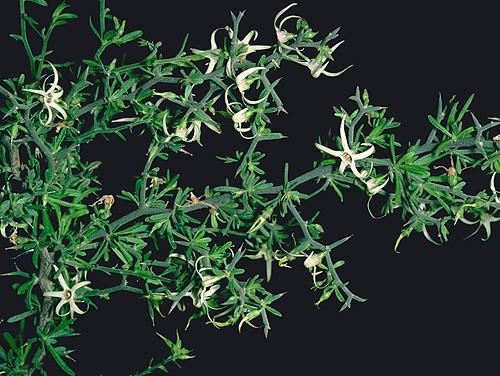
Synonymy
Anthocercis anisantha Endl., Stirp. Herb. Hügel. 13 (1838) subsp. anisantha
T: interior of south-western New Holland (south-western W.A.), Roe s.n.; holo: W.
Description
Spinescent shrub to 3 m, leafy to almost leafless, pubescent with predominantly glandular or non-glandular hairs, rarely glabrous. [CHECK]
Leaves narrowly elliptic, ovate, obovate, sessile or almost so, mostly 3–14 mm long, 1–3 mm wide, entire, often thick and fleshy or leathery.
Flowers in cyme-like, compact, terminal clusters; pedicels 2–6 mm long. Calyx 2–4.5 mm long. Corolla 7–20 mm long, white to yellowish, the striations purple-brown or maroon; lobes linear to narrowly ovate, 2.5–15 mm long. Stamens 2–6 mm long.
Capsule ovoid to ovoid-ellipsoid, acute, acuminate or apiculate, 4.5–9 mm long. Seeds 1.3–2 mm long.
Distribution and ecology
Occurs in south-western W.A. and on the mainland and offshore islands in the Port Lincoln area, S.A.
Usually grows in woodland or shrubland on undulating plains.
Notes
Distinct from subsp. collina by the predominantly glandular rather than non-glandular indumentum on the branches.
Information on the midges which form galls in the fruits of this species can be found in Lepschi et al. (1999).
Reference: Lepschi, B.J., Kolesik, P. & Gates, M. (1999). Notes on the fruit gall fauna of Anthocercis anisantha (Solanaceae) in
Selected specimens
W.A.: near Nukarni, A.M. Ashby 2501 (AD, PERTH); SE of Yuna, A.S. George 2381 (MEL, PERTH). S.A.: c. 10 km E of Port Lincoln, L. Haegi 1303 (AD, MO, NSW, PERTH).
Images and information on web
Images of this species can be seen on the FloraBase site at http://florabase.calm.wa.gov.au/browse/profile/11454
A fact sheet for this species can be downloaded from the SA eFlora site.
Pharmacology: A discussion of the tropane alkaloids which occur in Anthocercis and other Anthocercideae can be found in Griffith & Lin (2000).
Ref: W.J. Griffin & G.D. Lin (2000). Chemotaxonomy and geographical distribution of tropane alkaloids. Phytochemistry 53: 627–628.
References to the possible toxic properties of Anthocercis species can be found with a search in the
FDA Poisonous Plant DatabasePlant status (if any)
Without any declared rating in W.A. – see http://florabase.calm.wa.gov.au/conservationtaxa
Gazetted in February 2008 as Rare Flora in S.A. under the National Parks & Wildlife Act 1972 - see the list at www.environment.sa.gov.au/biodiversity/threatened.html


